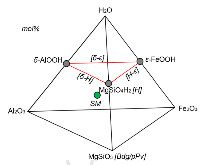Stability of Fe-bearing hydrous phases and element partitioning in the system MgO–Al2O3–Fe2O3–SiO2–H2O in Earth’s lowermost mantle
- Center for High Pressure Science and Technology Advanced Research (HPSTAR), Shanghai (China)
- Tohoku Univ., Sendai (Japan). Dept. of Earth Science
- Argonne National Lab. (ANL), Argonne, IL (United States). HPCAT, X-Ray Science Div.
- Univ. of Chicago, IL (United States). Center for Advanced Radiation Sources (CARS)
We performed high pressure–temperature (P-T) experiments on a model composition of hydrous subducted slabs in the MgO–Al2O3–Fe2O3–SiO2–H2O system using laser-heated diamond anvil cells. The phase assemblages were characterized combining in-situ synchrotron X-ray diffraction and ex-situ transmission electron microscope techniques. The hydrous δ-phase AlOOH–FeOOH–MgSiO2(OH)2–SiO2 coexists with bridgmanite (Bdg), post-perovskite (pPv), or both in a broad P-T range of 104–126 GPa and 1750–2500 K. The hydrous pyrite-type FeOOHx phase was observed in-situ over a P-T range of 112–123 GPa and 1750–2300 K, coexisting with the pPv phase. Chemical analysis on recovered samples showed that considerable amount of Fe2O2(OH)2 (8–13 mol%) and SiO2 (9–13 mol%) in the δ-phase does not reduce its thermal stability compared to the Al-endmember, indicating that the Fe-bearing δ-phase can transport water to the lowermost mantle along the mantle geotherm. In this hydrous system, we observed that Al depletion in both the Bdg and pPv phases can significantly reduce the width of the Bdg to pPv transition in contrast to a wide two-phase coexistence region in a dry Al-rich system. Meanwhile, the Fe enrichment in the pPv phase relative to the coexisting Bdg phase lowers the transition pressure to the depth of the D" discontinuity. Accordingly, the depth and thickness of the Bdg to pPv transition in subducted basaltic crustal materials can explain the seismically detected D" discontinuity. Partial melting could be triggered by dehydration of the Fe-bearing hydrous phases due to a steep temperature gradient at the core mantle boundary (CMB), and therefore the ultralow-velocity zones (ULVZs) might be the regions where partial melting occurs at the lowermost mantle.
- Research Organization:
- Argonne National Lab. (ANL), Argonne, IL (United States)
- Sponsoring Organization:
- USDOE; National Natural Science Foundation of China (NSFC); Japan Society for the Promotion of Science (JSPS)
- Grant/Contract Number:
- AC02-06CH11357
- OSTI ID:
- 1562108
- Alternate ID(s):
- OSTI ID: 1546112
- Journal Information:
- Earth and Planetary Science Letters, Vol. 524, Issue C; ISSN 0012-821X
- Publisher:
- ElsevierCopyright Statement
- Country of Publication:
- United States
- Language:
- English
Web of Science
Similar Records
Possible H2O storage in the crystal structure of CaSiO3 perovskite
Mineralogical effects on the detectability of the postperovskite boundary








